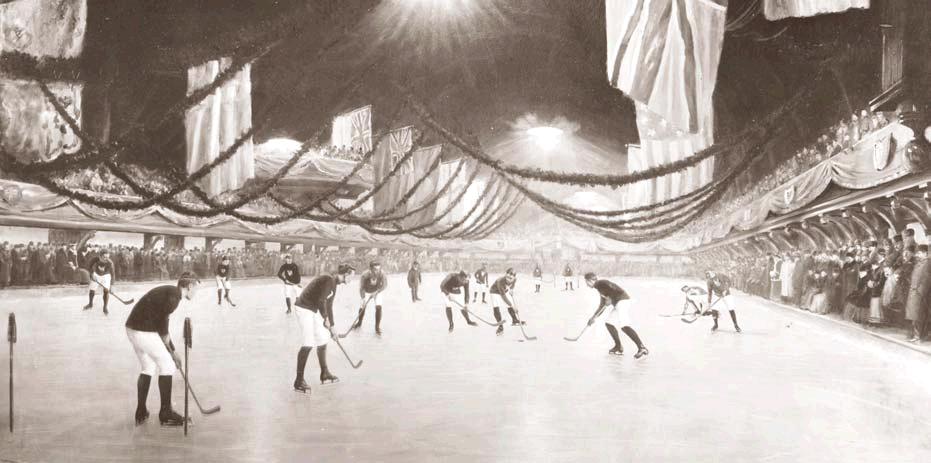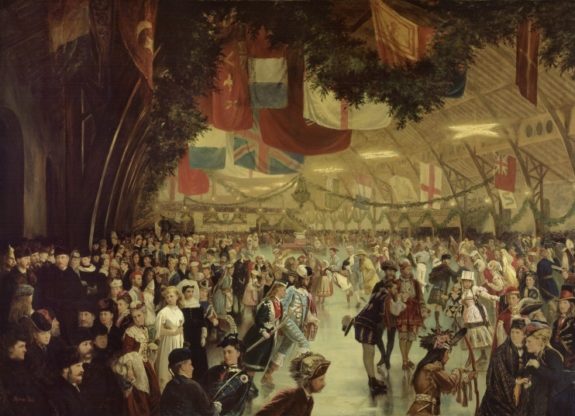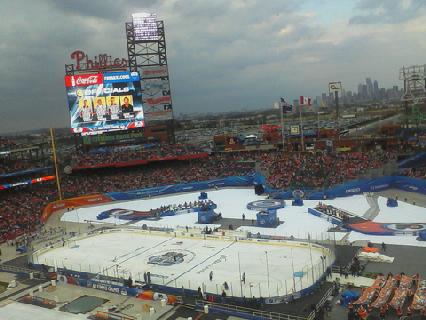This THW Archive piece was originally published in Dec. 2012.
And the music from the skating rink drifts across the town …
All across the world, the ice rink has become a home away from home for scores of hockey players and fans. From the sushi-serving confines of Scotiabank Arena in Toronto to the frozen metal bleachers of your local arena, as well as the wide range of outdoor locations in between, ice rinks are a place where the game can be learned, viewed and cherished by folks of all ages and backgrounds.
They’re a reminder that all you really need is a patch of ice, a stick, a puck and a net to enjoy the game we all love so much.
The Early Ice Rink
The concept of skating is said to date back some 3000 years, and is believed to have originated in Finland. It was the Dutch who came up with the idea of adding edges to ice skates in the 13th or 14th century; these skates were made of steel, with sharpened edges on the bottom, a basic construction that has stayed largely the same since then. The Dutch made use of skates on their extensive system of canals and waterways, and the activity was known to be enjoyed and utilized by many across Europe.

While the concept of the ice rink has become synonymous with the game of hockey, it was first associated with another winter sport. Scottish in origin, ‘rink‘ literally means ‘course‘, and it was used to describe the area where the game of curling was played. In the early days, ice rinks were natural in composition, meaning that a frozen body of water was used to host the games, and it wasn’t until much later on that cooling technology was developed to create artificial and indoor ice rinks.
First Indoor Hockey Ice Rink
Variations of both curling and hockey had been played for many generations prior to the naming of the playing area, but the origins of the modern, indoor ice rink can be traced back to Montreal, where the first organized indoor game was played at the Victoria Skating Rink in 1875. While the surface dimensions of the rink were basically what you would find at an NHL rink today ( 85 ft × 200 ft or 26 m × 61 m), the organizers of that first game made the wise decision to use a puck instead of a ball in order to protect spectators from flying objects in lieu of the now traditional boards. Located in central Montreal, it was home to the Montreal Winter Carnivals of the 19th century, and was also the location of the first Stanley Cup playoff games in 1894. The Victoria Skating Rink was sold in 1925, and today the site is home to a parking garage.

The early 20th century saw the dawn of professional hockey and the opening of several new ice rinks around North America, most notably the Mutual Street Arena in Toronto (1917–1931), the Montreal Arena (1911–1918), and the Aberdeen Pavilion in Ottawa, which remains one of the oldest surviving indoor ice hockey venues in the world (despite not having hosted a game for several years).
The most famous of the early ice rinks that hosted professional hockey teams belonged to the “Original 6”: the first Madison Square Garden in New York (1926–1968), the Boston Garden (1928–1995), the Montreal Forum (1926–1996), Maple Leaf Gardens (1931–1999), Chicago Stadium (1929–1994) and the Olympia in Detroit (1927–1979). While these ancient cathedrals of hockey are with us no more, they were destinations of pilgrimage for many hockey fans over the years, and their memories live on despite having been razed or turned into grocery stores.
The Ice Rink Today

At present, there are 32 ice rinks spread across North America that NHL teams call home. The oldest such buildings are Climate Pledge Arena (Seattle) and Madison Square Garden (New York). Most NHL teams have rinks that were built in the 1990s or 2000s, the newest of which can be found in Arizona (Mullett Arena – 2022), Long Island (UBS Arena – 2021), and Detroit (Little Caesars Arena – 2017). The arena in Arizona is also the NHL’s smallest, with a maximum capacity of 4,600; the biggest rink can be found in Montreal, with the Bell Centre boasting a maximum capacity of 21,105.
Europe has its fair share of hockey rinks as well, most notably the Ericsson Globe in Stockholm, the O2 Arena in Prague, the Megasport Arena in Moscow and the PostFinance-Arena in Bern.
But with the advent of the lavish indoor arena comes certain mythology behind the outdoor versions, and people all over the world flock to them to enjoy an open-air skate or a game of shinny. Winnipeg and Ottawa are privy to two of the world’s biggest and most well-known outdoor ice rinks: the Red River Trail and the Rideau Canal Skateway, both of which attract thousands as the weather permits.
The NHL Returns to the Outdoor Ice Rink
Hockey fans have also gone wild over the idea of outdoor hockey games in recent years, as evidenced in the popularity of the Heritage and Winter Classics. Rinks have been set up in football and baseball stadiums, and have been packed with fans eager to recapture that pond hockey nostalgia.
While the Big House edition of the Winter Classic was postponed due to the 2012 NHL lockout, an outdoor game this past fall provided perhaps the ultimate backdrop, an ice rink that may never be topped. On Friday, Sept. 14, and Sunday, Sept. 16, 2012, the Austrian-based Erste Bank Eishockey Liga (EBEL) held an event called “Arena Ice Fever — Pula MMXII,” which featured a pair of games at the Pula Arena, a nearly 2,000-year-old Roman amphitheater.

The two games were the first known team sports events held at the ancient venue, and the first ice hockey games in history to be held in an amphitheater setting. The home team for both games was KHL Medvescak Zagreb (the Zagreb Bears), a Croatian-based EBEL team. The visiting team for the first game was the EC Vienna Capitals, while Olimpija Ljubljana from Slovenia provided the opposition in the second match.
Whatever the setting, there certainly is some romanticism involved when the topic of the ice rink pops up, and many a song and poem has been written on that very topic. Prior to the 2003 Heritage Classic at Edmonton’s Commonwealth Stadium (the first regular-season NHL game to be played outdoors), the CBC aired this tribute to the ice rink by Canadian songwriter David Francey, who, in a full-circle moment, hails from the nation of Scotland, where the rink first got its name.

Ian, this article is fantastic. Had my attention the entire read. Great work.
Thank you, Justin. Very much appreciated.